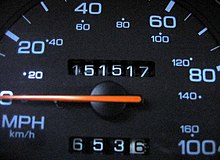Odometer
An Odometer or Engl. Odometer (from ancient Greek ὁδός hodós , German 'way' and μέτρον métron 'measure', so "odometer") mechanically measures a distance covered by a vehicle or pedestrian . The science of mechanical displacement is hodometry .
history
Europe

The odometer was invented in ancient times . The first indications that indicate the existence of a mechanical range finder can already be found in the time of Alexander the Great (reign 336–323 BC) in the form of the surprisingly accurate distance information provided by trained pedometers, so-called Bematists , as used by the Roman writer Pliny ( NH 6. 61–62) and Strabo (Geographica 11.8.9) were handed down. The mean deviation of the distances given by the Bematists from the actual distance is only 2.8 percent for Pliny and 1.9 percent for Strabo for a total distance of 2013 or 2079 English miles - a noticeably slight deviation that is also reflected in the can explain changes in route over the past 2000 years.
The first descriptions of an odometer in the literature can be found with the Roman engineer Vitruvius (1st century BC) and the Greek inventor Heron of Alexandria (1st century AD). Both describe a device that, like a mechanical odometer that is still common today, transmits the rapid movement of a measuring wheel to increasingly slower gears or disks with hooks. The precisely measured Roman roads with their traditional miles between the individual places in Roman documents, e.g. B. in the Itinerarium Antonini , lead to the conclusion that this measuring device served as an official range finder 2000 years ago. With a miniature version, distances can be "tracked" and displayed on maps.
In 1604 Levin Hulsius presented the odometer in its broad application, in a treatise with the title: Thorough description of the Diensthafften und Nutzbahrn Instruments Viatorii or odometer, So on foot, on horseback and on foot can be used so that it is easy to know how far one has walked, ridden, or driven: as well as knowing without measuring or counting how far from one orth to another. In addition, the large hidden signpost is displayed and reported.
China
The odometer was later also invented in ancient China , possibly by the inventor and scientist Zhang Heng (78-139) from the Han dynasty . In the third century, during the Three Kingdoms , the Chinese called the device ji li gu che , in German " Li recording drum cart". According to Chinese reports from the third century, a wooden figure turned once on its axis while the car covered a li , beating a drum in the process. After ten li, another wooden figure struck a gong or bell.
Despite its association with Zhang He or the later Ma Jun, there is evidence that suggests that the invention of the odometer was an ongoing process in the Han dynasty involving the Huang men , members of the court.
Historian Joseph Needham assures that it would not be a surprise if this class of society had been responsible for developing such a device, especially since they had demonstrated their inventiveness and craftsmanship in mechanical toys. There are assumptions that in the first century BC, during the western Han dynasty, the beat of the drums and gongs already worked automatically. Possibly it was a construction of a Loxia Hong (110 BC). In the year 125 AD, the mechanical odometer cart was well known in China, as shown in a mural on the Xiao Tang Shan coffin. The odometer was also used in later periods of Chinese history. Its use was described in the texts of the Jin Shu from 635.
Technical characteristics
The best known form of the odometer is probably the odometer in vehicles (not to be confused with the speedometer , which measures the speed of the vehicle). In addition, there are numerous other special forms:
- The curvimeter is used to measure the distance on a map .
- The pedometer counts the number of steps a person or animal takes.
- The taximeter shows the amount of money to be paid for a taxi ride .
- The cyclometer is a device for measuring the distance traveled on bicycles (first used in Austria in 1885 for military bicycles).
literature
- Donald W. Engels: Alexander the Great and the Logistics of the Macedonian Army. University of California Press, Berkeley CA et al. 1978, ISBN 0-520-03433-3 .
Web links
- Shockwave animation: Vitruvius's odometer (antiquity) ( Memento from September 7, 2011 in the Internet Archive )
Individual evidence
- ^ Donald W. Engels: Alexander the Great and the Logistics of the Macedonian Army. 1978, p. 157 f.
- ↑ Ralf Kern: Scientific instruments in their time. Volume 2: From Compendium to Individual Instrument. 17th century. König, Cologne 2010, ISBN 978-3-86560-866-6 , p. 470.
- ^ A b John Needham: Volume 4, p. 281.
- ↑ a b c John Needham: Volume 4, p. 283
- ^ John Needham: Volume 4, p. 282



